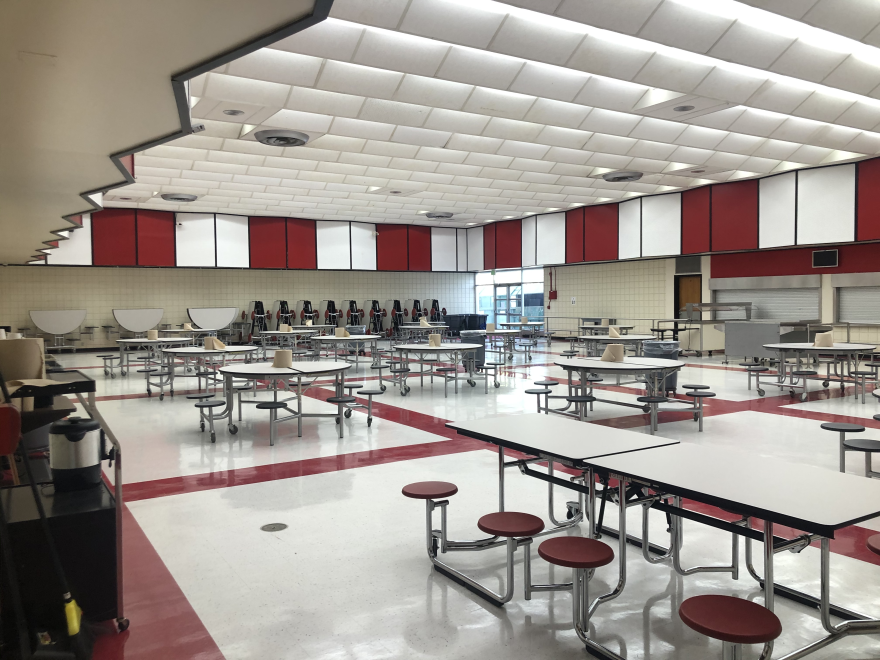Inside a Kenai Peninsula Borough School District Board of Education meeting Monday, parents, students and staff gave mixed testimony on the district’s adherence to a remote learning plan. Outside the meeting, on the sidewalk in front of Kenai Central High School, a group of 40 protesters held signs with messages like “I want 2-B in school,” “No fear” and “Open our schools.”
Kimberly Powell has a daughter in seventh grade and a son in fifth grade at Skyview Middle School. She said she owns her own business, which has made learning from home difficult.
“Both of my children are super good students, but it’s really affecting them," she said. "They’re depressed, they’re less compliant, they’re a little more argumentative. They’re not being able to be around their friends and their peers, which is important for them.”
Rhonda White and Jennifer Ellis, of Nikiski, organized the protest on Facebook. Ellis said there are a lot of gaps in her kids’ education and she doesn’t feel equipped to help. She thinks remote learning has gone on for too long.
“There’s so many of us that need our children — we want our children to have a proper education. I’m doing my very best as a stay-at-home mom to be with these kids, but I can’t fill in the gaps," Ellis said. "I can’t teach my daughter Algebra II, I don’t remember it, you know? And she’s emailing her teacher for questions and it’s a delayed response time and there’s so many issues. I’ve got an 11-year-old in front of her computer screen five to six hours a day. They’re complaining of headaches, depression, lack of motivation.”
Ellis and White said the bar for shifting to remote learning is too low. The school district currently considers schools “high risk” if the average daily incidence over the last two weeks has been more than 10 cases per 100,000 people. Currently on the central peninsula, the case count is at 356.
In Anchorage, the debate over in-person and remote learning has been heated, as well. That district is planning on reopening schools Nov. 16. At a recent board meeting, teachers expressed concern about going back to the classroom.
Superintendent Deena Bishop said she’s worried about children falling behind and students’ mental health. She said three students had died by suicide in the last few weeks.
Anchorage teachers and school nurses have largely spoken against returning to school. The district is also getting pushback from its teachers union about the return to in-person classes. Same with unions in KPBSD.
David Brighton, president of the Kenai Peninsula Education Association, and Anne McCabe, president of the Kenai Peninsula Education Support Association, spoke in favor of the Smart Start plan at Monday’s meeting. McCabe said the first time staff are exposed to cases and sent into two-week isolation, they’re paid by Emergency Paid Sick Leave Act funds.
“The second time they’re exposed, it comes out of their sick leave, if they have it," she said. "When teachers and support staff run out of sick-leave time, it puts them into non-paid status. So for many of our teachers and support staff, it will only take two exposures before they’re in non-paid status. If they roll into the first of a month without being in paid status, their health insurance is at risk.”
McCabe said the district is also still facing a substitute shortage, which leads to combining classrooms and increases the risk for exposure.
Like several other parents at the meeting and protest, Harrison Deveer, the soccer coach for Nikiski Middle-High School and a paramedic, said he worries about kids’ mental health.
“Online education is not it. I started a petition about a week ago and I currently have about 174 parents who have signed it," he said. "I understand COVID’s a deadly disease. But know what else is deadlier than COVID when we talk about kids? Suicide. About 136 per year in Alaska."
On the other side of the issue, Mandy Patrick, a Kenai parent, said that while kids are less likely to experience the most-severe form of the virus they can spread it to populations that are at higher risk.
“I just want to show support for your Smart Start protocol because I really appreciate the fact that you guys are looking out for the health of the at-risk students, parents, teachers, everyone out there that may have preexisting health conditions that are really kind of getting the short end of the deal on this one, especially our elderly teachers and stuff," she said. "You know, it’s not really fair to send a lot of kids in there and say, ‘Well, the kids aren’t getting that sick, it will be fine.’ Well, what about them?”
Nathan Erfurth, who teaches at Soldotna High School, said the community can determine the trajectory of the virus, since the district bases its decisions about in-person learning off community case counts.

“There’s no question that students in general learn better in person. As a professional educator, I have always argued that in-person education is the most effective method," he said. "I want to be back as much as every other caller so far. I understand. However, we backed ourselves into this as a community, and we can only get out of it as a community. Schools haven’t failed the community, the whole community has."
On Tuesday, the school district announced it is extending remote learning at least through Nov. 13. Director of Communications Pegge Erkeneff said the district understands the stress placed on families by remote learning and the district is working on mitigation plans to bring more students back into school buildings during high-risk status. At this time, some pre-k, kindergarten and special needs students are attending in-person classes.
She said any substantial changes to operation in high risk times would involve input from the community and require approval by the board of education.





